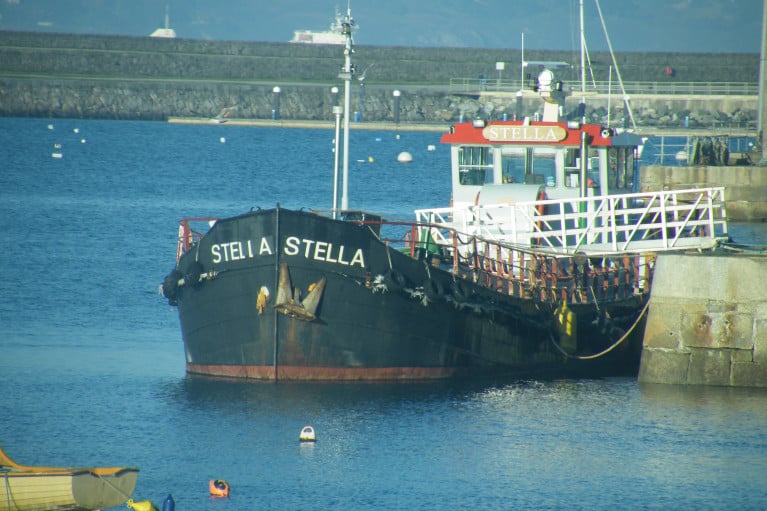During a self-imposed 'semi' day-off which took place on this day last week, several small 'motor'-powered vessels were observed during a brief visit to the marina in Dun Laoghaire Harbour and environs, writes Jehan Ashmore.
It was in Dun Laoghaire Marina which can accommodate leisure craft in 820 berths, was moored the heritage tug Swiftstone, which Afloat has tracked since April but then at Arklow Harbour. The veteren tug built in 1952 by Richard Dunston in the UK for Cory Lighterage Ltd for use on the River Thames, was undergoing final refurbishment in the Co. Wicklow port. Notably the former tug is listed on the National Historic Ships UK register, the official voice for historic/heritage vessels.
The low-profile sleek lined Swiftstone was tracked by Afloat last weekend while transitting Dalkey Sound with a return to Dun Laoghaire Harbour via Killiney Bay. This involved a passage back but between the island and islet of the Muglins complete with light-beacon marking the southern approaches of the Dublin Bay.
Also occupying a berth within Dun Laoghaire Marina was the customary presence of a reserve RNLI lifeboat. On this occasion the name of Trent class craft could not be identified, given observation took place from a 'DART' train heading towards Dublin to make also a visit that day to the port (report to follow).
Despite not logging this lifeboat's name, a former Dutch barge, Stella, which still retains its name with origins from the 'lowlands' nation berthed elsewhere in the form of the 'Harbour Splash' barge. This is Dublin’s first inflatable aqua park which will be not open in 2020 but will be back in May 2021.
Interestingly, Stella is berthed 'Meditteranean' style where the stern is moored at right-angles to the Old Pier, (constructed in 1767) therefore the most historic pier given the bi-centenary of the harbour held in 2017 commemorated the start of constructing the 'Victorian' port of refuge. As for the embarkation of the Stella, this is made possible using a gangway linking the pier and the stern of the barge.
The practice of 'Med'-mooring is also routinely carried out in home waters too. But where? The answer is notably to be seen among some of our fishing harbours and ports, notably that of Killybegs, Co. Donegal. This even involves the largest of the Irish fishing fleet's supertrawlers to berth in this way and can include 'rafting-up' of several vessels, which also takes place in Dun Laoghaire albeit where the small fishing fleet berth conventionally alongside Traders Wharf.
Following the previously mentioned visit to Dublin Port (to be published) a repeat call was made to Dun Laoghaire but this time alighting from the DART to see the arrival to the harbour of St. Bridget, marking the end of a day's work of daily routine operations by Dublin Bay Cruises.
As St. Bridget edged cautiously to berth at St. Micheal's Pier /Wharf, a bow-thruster was put into to action before mooring lines were tied up. DBC were due to begin the seasonal cruises back in March during St. Patrick's Festivel however Covid-19 health restrictions delayed such plans.
The former Aran Islands / West coast islands passenger ferry now provides (up to 7 cruises) is Dun Laoghaire based (notably from East Pier) with St. Bridget beginning morning cruises firstly to Dublin city-centre and theron throughout the day with calls to Howth Harbour and Dun Laoghaire from where there is an around the Dalkey Island cruise including Killiney Bay.
Returning to St. Michael's is where the harbour's sole surviving refurbished ferry ro-ro linkspan (without pontoon) which served Stena Line remains in situ.
The infrastructure was last in use by the 'Lynx' fastferry Stena Lynx III until 2011 and not to be confused with the (HSS) fastferry Stena Explorer which ceased seasonal sailings also to Holyhead until almost six years ago. This took place in September 2014, as dictinct to not operating in the following year as the mainstream media widely reported.
As in 2015, Stena confirmed they would not return to serve the south Dublin Bay harbour but concentrate on neighbouring Dublin Port. As the ferry operator had an existing route between the Irish capital and Holyhead which began in 1995. Initially though this was a freight-only operation.
So this leaves DBC as the only commercial operator in a port that potentially and deservedly has more to offer asides been the homeport of Irish Lights tender ILV Granuaile, visiting Naval Service patrol vessels and superyachts.
Due to lack of quay-space in Dublin in recent years and ironically exasperated by the construction of port infrastucture projects underway, this has led to occasional cargoships berthing in Dun Laoghaire for a variety of reasons.
This temporary scenario in Dublin Port had left cruiseships restricted in using the capital was due to a limit imposed by the port on the number of cruiseships visiting due to capacity constraints coupled with the impact of Brexit. So works notably the Alexandra Basin Redevelopment (ABR) Project which is still ongoing to address the issue of Brexit and the trend to enable larger sized cargoships and cruiseships be accommodated as part of the Port's Masterplan.
So this year's Dun Laoghaire Harbour's cruise season was going to be considerably different with Covid-19 severely impacting the sector. In addition the artificial spillover of cruiseships from Dublin to Dun Laoghaire was hence dealt a severe blow as the vast majority, 20 out of 22 cruise callers scheduled have so far been cancelled.

























